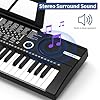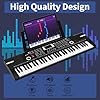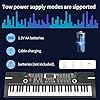Table of Contents
Introduction to Building a Consistent Piano Practice Routine
Developing a consistent piano practice routine is essential for anyone looking to improve their skills and become a proficient pianist. Whether you are a beginner trying to set the right foundations or an experienced player aiming to hone your artistry, the key to progress lies in regular and methodical practice. This introduction provides the essential steps to help you structure your daily piano practice effectively, ensuring optimal improvement and sustained motivation over time.
Creating a Daily or Weekly Practice Schedule
Techniques for Staying Focused During Practice
Before you start your practice session, define specific goals you want to achieve. Whether it’s mastering a particular piece, improving your scales, or working on dynamics, having clear objectives can provide direction and keep you focused throughout your session.
Piano: Learn The Piano in 5 Easy Steps: A Self-Guided Piano Course for Beginners (with Online Video Instruction - Piano Learning Books for Beginning Piano Players)
17% OffScales and Finger Exercises for Piano | Classical Technique Sheet Music Book for Beginners and Intermediate Players | Major and Minor Scales and ... Library of Musical Classics, 2107)
$9.99 (as of November 22, 2025 23:14 GMT -08:00 - More infoProduct prices and availability are accurate as of the date/time indicated and are subject to change. Any price and availability information displayed on [relevant Amazon Site(s), as applicable] at the time of purchase will apply to the purchase of this product.)Music Practice Notebook: Get more out of music lessons with this useful notebook | Includes weekly tips a music theory guide, how to practice guide and blank manuscript paper
$6.00 (as of November 15, 2025 23:26 GMT -08:00 - More infoProduct prices and availability are accurate as of the date/time indicated and are subject to change. Any price and availability information displayed on [relevant Amazon Site(s), as applicable] at the time of purchase will apply to the purchase of this product.)37 Simplified Classical Pieces for Piano: Easy scores of timeless pieces for beginners. Play the songs that made history and progressively improve your skill!
$9.97 (as of November 22, 2025 22:22 GMT -08:00 - More infoProduct prices and availability are accurate as of the date/time indicated and are subject to change. Any price and availability information displayed on [relevant Amazon Site(s), as applicable] at the time of purchase will apply to the purchase of this product.)Break down your practice time into manageable chunks using a timer. For example, practice a particular technique for 20 minutes and then take a short break. This method, often referred to as the Pomodoro Technique, helps maintain concentration by preventing mental fatigue.
Create a practice environment where distractions are minimized. Turn off notifications on your devices, choose a quiet room, and let family members or housemates know that you need uninterrupted time. An environment free of disruptions helps you maintain better focus.
Sitting with proper posture and ensuring that your piano bench height is adjusted correctly can make a significant difference. Being physically comfortable allows you to concentrate better on your practice rather than getting distracted by discomfort.
Document your progress, challenges, and achievements in a practice journal. This log can help you stay motivated and focused as you can see how far you have come and what areas require more attention. Reviewing your journal before each session can realign your focus with your goals.
Piano: Learn The Piano in 5 Easy Steps: A Self-Guided Piano Course for Beginners (with Online Video Instruction - Piano Learning Books for Beginning Piano Players)
17% OffScales and Finger Exercises for Piano | Classical Technique Sheet Music Book for Beginners and Intermediate Players | Major and Minor Scales and ... Library of Musical Classics, 2107)
$9.99 (as of November 22, 2025 23:14 GMT -08:00 - More infoProduct prices and availability are accurate as of the date/time indicated and are subject to change. Any price and availability information displayed on [relevant Amazon Site(s), as applicable] at the time of purchase will apply to the purchase of this product.)Music Practice Notebook: Get more out of music lessons with this useful notebook | Includes weekly tips a music theory guide, how to practice guide and blank manuscript paper
$6.00 (as of November 15, 2025 23:26 GMT -08:00 - More infoProduct prices and availability are accurate as of the date/time indicated and are subject to change. Any price and availability information displayed on [relevant Amazon Site(s), as applicable] at the time of purchase will apply to the purchase of this product.)37 Simplified Classical Pieces for Piano: Easy scores of timeless pieces for beginners. Play the songs that made history and progressively improve your skill!
$9.97 (as of November 22, 2025 22:22 GMT -08:00 - More infoProduct prices and availability are accurate as of the date/time indicated and are subject to change. Any price and availability information displayed on [relevant Amazon Site(s), as applicable] at the time of purchase will apply to the purchase of this product.)Before starting your practice, take a few moments to center yourself with deep breaths and clear your mind. Practicing mindfulness can improve your concentration and help you be more present and focused during your session.
Switching between different exercises or pieces every 10-15 minutes can keep your practice sessions dynamic. This technique prevents monotony and keeps your brain engaged, making it easier to stay focused over longer periods.
Spend a few minutes visualizing yourself successfully performing the pieces or techniques you are working on. This mental rehearsal can improve your focus and boost your confidence, making your practice sessions more effective.
The Importance of Warm-Up Exercises
Warm-up exercises are essential in any piano practice routine as they prepare both the mind and body for more intensive activity. These exercises help to increase blood flow to the muscles, which can reduce the risk of injury and improve overall performance. Additionally, warm-ups serve to mentally transition from other daily pressures into the focused state necessary for productive practice.
Beginning your practice session with warm-up exercises improves your technical precision. Simple scales, arpeggios, or even slow pieces allow pianists to focus on their finger movement, hand alignment, and touch sensitivity, which are crucial for developing fine motor skills.
Warm-up exercises also contribute to long-term muscle memory development. Consistently starting with these exercises reinforces the basic skills and motions needed to tackle more complex compositions. Over time, this repetition creates a strong foundation, making advanced pieces more accessible.
Moreover, warm-ups can significantly enhance musical expression. They provide an opportunity to concentrate on dynamics and phrasing without the complexity of a full piece. This focus on detail ensures that when a pianist moves on to their main repertoire, they can incorporate a greater level of expressiveness into their performance.
Lastly, incorporating warm-up exercises into your practice routine aids in building a sustainable practice habit. A predictable start with familiar exercises can ease the transition into practice sessions, especially on days when motivation is low. This routine helps in maintaining consistency, which is key in mastering the piano.
How to Set and Achieve Short-Term Piano Goals
Setting and achieving short-term goals is crucial for developing your skills and building confidence as a pianist. Here is a structured approach to help you on this journey:
Begin by defining clear, specific objectives for your piano practice. Instead of vague goals like “get better,” choose targets that are measurable and attainable within a short timeframe, such as learning a specific piece of music or mastering a particular technical skill within a week or two.
To avoid feeling overwhelmed, break your goals into smaller, manageable steps. For instance, if your goal is to learn a new song, divide it into sections and focus on one section at a time, setting daily or weekly targets for each part.
Maintain a consistent practice schedule. Determine a regular time of day for your piano practice and stick to this schedule as closely as possible. Consistency is key to progress and helps to form productive habits.
Employ specific practice techniques that focus on your goals. For technique improvement, consider using exercises like scales, arpeggios, or Hanon exercises. For learning pieces, utilize slow practice, hands-separate practice, or chunking methods to work on difficult passages.
Keep track of your progress by writing down your practice activities and achievements in a journal or a digital app. Review your progress regularly to adjust your goals and techniques as needed, ensuring you remain on track and motivated.
Seek feedback from teachers or peers to get an outside perspective on your playing. Regular feedback helps identify blind spots in your technique or interpretation that you might not notice on your own.
When you achieve a goal, take a moment to celebrate it. Whether it’s treating yourself to something special or simply taking time to reflect on what you’ve accomplished, recognizing and rewarding your progress is important for maintaining motivation.
As you progress, you may find some goals become too easy or too difficult. Be flexible and adjust your goals accordingly to ensure they remain challenging yet achievable. This flexibility helps maintain your interest and commitment to your piano practice.
Balancing Technical Practice with Song Learning
A crucial aspect of building a consistent piano practice routine is balancing technical practice with song learning. Both areas are essential but require different approaches. Here’s how to effectively integrate them into your practice sessions:
Allocate Time for Each
Devote a specific portion of your practice time to technical exercises and another to song learning. For instance, if you have an hour to practice, spend the first 20-30 minutes on technical exercises and the remaining time on songs. This ensures that you cover all necessary aspects without compromising on either.
Set Goals for Both
Set clear, achievable goals for both technical practice and song learning. For technical practice, these goals might include mastering scales, arpeggios, or specific finger exercises. For song learning, focus on progressing through sections of the piece, improving tempo, or refining dynamics.
Use Smart Practice Techniques
Incorporate smart practice techniques such as chunking (breaking pieces into smaller sections), slow practice, and hands-separate practice to maximize efficiency. These techniques are valuable for both technical exercises and learning new songs, helping to build muscle memory and precision.
Integrate Relevant Technical Exercises
Choose technical exercises that directly support the songs you’re learning. If your song features challenging scales or arpeggios, incorporate those specific exercises into your technical practice. This makes your technical practice more relevant and immediately applicable to your repertoire.
Track Your Progress
Keep a practice journal to track your progress in both technical skills and song learning. Documenting what you’ve accomplished and what needs further work helps in maintaining a balanced focus and recognizing improvements over time.
Review and Adjust Regularly
Regularly review your practice routine and make adjustments as needed. If you find that you’re stagnating in either technical skills or song learning, shift your focus accordingly. Flexibility allows you to address weaknesses and capitalize on strengths.
Stay Consistent
The most important factor is consistency. Maintaining a daily balance between technical practice and song learning ensures steady progress. Even on days when you have limited time, touching on both areas, even briefly, helps reinforce the skills and knowledge you’re building.






























